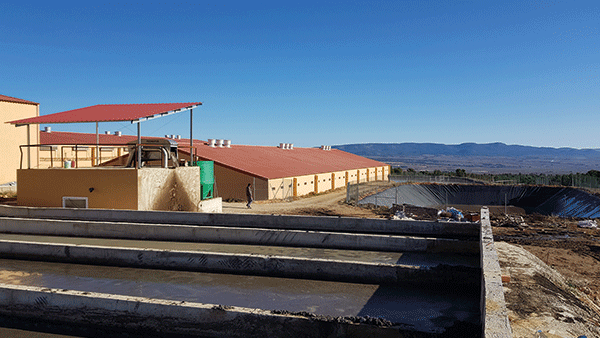Blog
Blog

Biological treatment of pig slurry (II/II)
27th May 2025 - News
Óscar Toledano. Rotecna Sales Manager.
As we discussed in previous articles, the treatment of slurry is crucial both from an environmental point of view and to maximise the use of the nutrients it contains. On other occasions, we talked about the physical and chemical treatments that we can perform, and in the previous article, we described the main biological treatments; in this one, we are going to focus on the bacteria, how they affect it and what components and effects they produce.
Below, we will describe several microorganisms, how they behave and what components and effects they produce grouped according to the mechanism of their metabolism.
AEROBIC BACTERIA
They are the bacteria that need oxygen and do not survive without it. Aerobic bacteria play a vital role in breaking down organic matter in slurry, reducing odours and improving slurry quality as fertiliser. Their combined action ensures that the slurry is more manageable, reduces its polluting prospect and increases its fertilising properties. Properly managing these bacteria through aeration and treatment can maximise their benefits and contribute to more sustainable and efficient waste management practices. Some types of aerobic bacteria commonly found in pig slurry and their effects are described below:
- Genus Bacillus: These spore-forming bacteria produce enzymes that break down proteins, lipids, and complex carbohydrates. They also decrease the production of foul-smelling compounds such as ammonia and volatile fatty acids. They resist adverse environmental conditions and are commonly used in biological slurry treatments.
- Genus Pseudomonas: These are non-spore-forming bacteria known for their ability to degrade a wide variety of organic compounds. They are effective in eliminating odours and reducing the organic load. They also oxidise foul-smelling compounds and reduce the concentration of hydrogen sulfide (H2S) and ammonia, and they emulsify fats and oils, improving their degradation.
- Genus Nitrosomonas: These bacteria oxidize ammonia (NH3) to nitrite (NO2-), a crucial step in the nitrogen cycle. This reduces the volatilisation of ammonia and thus its contribution to odour. On the other hand, nitrification converts ammonia into nitrogen, which crops absorb more easily.
- Genus Nitrobacter: These bacteria take nitrite (NO₂⁻) generated by Nitrosomonas and convert it to nitrate (NO₃⁻), completing nitrification.
- Genus Alcaligenes: Capable of degrading various organic compounds, they contribute to the reduction of volatile organic matter. Alcaligenes faecalis can oxidise sulfur-reducing compounds, decreasing the production of hydrogen sulfide (H2S).
- Genus Micrococcus: These bacteria break down various organic compounds and improve the quality of the slurry. Some species can produce compounds that inhibit pathogens' growth, improving the treated slurry's safety.
- Genus Streptomyces: These bacteria produce enzymes that degrade cellulose, lignin, and other organic macromolecules. They also help break down smelly compounds and improve the overall quality of the slurry.
ANAEROBIC BACTERIA
They do not use oxygen and can die in its presence (stringent anaerobic ones). These bacteria are fundamental in anaerobic digestion, where methanogenic, acetogenic, hydrolytic, fermentative and sulfate-reducing bacteria work together to break down organic matter, produce biogas, and reduce the biological demand for oxygen, thus improving the quality of the slurry and reducing its environmental impact. These processes enhance the efficiency of livestock waste management and contribute to producing renewable energy and reducing odours and pathogens.
- Genus Clostridium: Includes bacteria that ferment organic matter, producing volatile fatty acids, hydrogen, and carbon dioxide. Methanogenic archaea use these products in the next stage of the anaerobic process. They also break down proteins, lipids, and carbohydrates into simpler compounds, facilitating subsequent methanogenesis.
- Methanogenic microorganisms: These archaea, not bacteria, convert volatile fatty acids and hydrogen into methane and carbon dioxide. They are crucial in the production of biogas in anaerobic digesters. Converting organic compounds into biogas reduces the biological oxygen demand (BOD) and the slurry's total amount of organic matter.
- Denitrifying bacteria: After the aerobic nitrification stage, in the anaerobic denitrification stage, the bacteria convert nitrate (NO₃⁻) into nitrogen gas (N₂), which is released into the atmosphere. Among the main denitrifying bacteria are Pseudomonas, Paracoccus and Bacillus. These bacteria alternate between aerobic respiration and denitrification. In oxygen-free environments, they change their enzymes and metabolic pathways to perform nitrate reduction instead of oxygen. This allows them to survive and perform denitrification under anaerobic conditions.
- Fermentative Bacteria (Lactobacillus and Enterococcus): These bacteria ferment the products of hydrolysis (sugars and amino acids) into organic acids (such as lactic acid), alcohols and gases such as hydrogen and carbon dioxide. In addition, fermentative activity can help reduce the production of smelly sulfur compounds. In the first stage of anaerobic digestion, these bacteria convert organic polymers (carbohydrates, proteins, lipids) into volatile fatty acids, alcohols, and gases, such as hydrogen and carbon dioxide.
- Sulphate-Reducing Bacteria (Desulfovibrio and Desulfobacter): Sulphate-reducing bacteria are common in treating pig slurry due to their ability to reduce sulfates to hydrogen sulfide. While the production of H₂S can be problematic due to its odour and corrosivity, properly managing these bacteria and implementing control technologies can mitigate these effects. In addition, they may have benefits in terms of heavy metal precipitation, contributing to a safer and more efficient treatment of pig slurry.

Slurry treatment plant. Photo: Rotecna.
FACULTATIVE BACTERIA
Facultative bacteria are crucial in the treatment of pig slurry due to their ability to adapt to different oxygen conditions, both aerobic and anaerobic, allowing them to adapt to different environments within the slurry treatment system. These bacteria break down organic matter, reduce odours, and improve the quality of the slurry. Its use in microbial inoculants and treatment systems ensures efficient and sustainable management of pig slurry. Some of the most common facultative bacteria used commercially in the treatment of pig slurry and their effects are described below:
- Genus Enterobacter: They can degrade organic matter in the presence or absence of oxygen, producing acids and gases under anaerobic conditions. It also helps reduce odours by degrading volatile and smelly compounds.
- Genus Escherichia: Although best known for their role in the gut microbiota, some strains can decompose organic matter under variable oxygen conditions, reducing biological oxygen demand (BOD). In addition, they ferment carbohydrates to produce organic acids and gases such as carbon dioxide (CO2) and, to a lesser extent, methane (CH4) under anaerobic conditions.
- Genus Klebsiella: Capable of degrading a variety of organic compounds, improving the slurry quality. It produces organic acids and alcohols during anaerobic fermentation.
- Genus Streptococcus: Contributes to organic matter decomposition under aerobic and anaerobic conditions. It also produces organic acids during fermentation, helping to stabilise the slurry.
The selection and management of suitable bacteria for decomposing the solid parts of pig slurry is essential for efficient treatment. The combined use of different types of bacteria, each with its specific role, can maximise the decomposition of organic matter, reduce odours and emissions, and improve the quality of the resulting fertiliser.
A slurry treatment can directly inoculate specific bacterial cultures to initiate or accelerate the decomposition process and promote the proliferation of one or another bacteria to obtain the desired effect. It can also generate conditions that maximise the growth and activity of the microorganisms that interest us, maintaining the right temperature, pH, and humidity for the development and activity of the selected bacteria.








